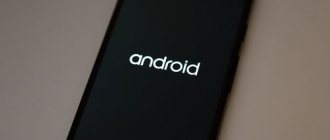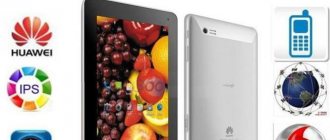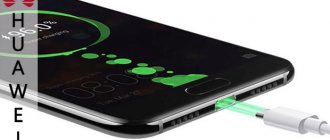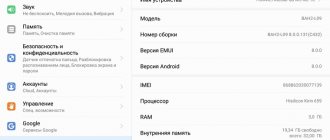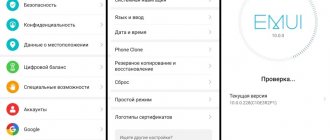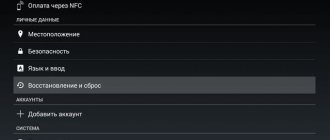The line between smartphones and tablets continues to blur, becoming thin, almost invisible. Numerous and quite popular “plafonds” (smart phones, phablets - choose from these stupid words the one that you personally like) like the Samsung GALAXY Note - something in between smartphones and tablets - are to blame for this. And in general, the dimensions of mobile phones have grown significantly over the past couple of years. Determining what exactly is in front of you – a large smartphone or a small tablet – is not always easy these days.
Historically, gadgets with a display diagonal of seven inches or more are considered to be tablets, and those with a smaller display diagonal are considered smartphones. The MediaPad X2 has a screen of exactly seven inches. That is, by nomenclature (and by name) it is a tablet. However, the gadget turned out to be so compact that, if necessary and with due diligence, it can fit in some wide pocket of a jacket or jacket. In addition, you can make calls from it in GSM networks, and it has two slots for SIM cards at its disposal. So Huawei MediaPad X2 is another bright representative of the “smart tablet” subclass.
⇡#Technical characteristics
| Huawei MediaPad X1 | Huawei MediaPad X2 | |
| Display | 7 inches, 1920 × 1200, matrix type – IPS + LTPS | 7 inches, 1920 × 1200, matrix type – IPS + LTPS |
| Touch screen | Capacitive (10 points), responds to touches with loose gloves | Capacitive (10 points), responds to touches with loose gloves |
| Air gap | No | No |
| Oleophobic coating | Eat | Eat |
| Polarizing filter | Eat | Eat |
| CPU | HiSilicon Kirin 910 (Hi6620): four cores ARM Cortex-A9 (ARMv7), frequency 1.6 GHz; 32-bit computing 28 nm HPm process technology | HiSilicon Kirin 930: four cores ARM Cortex-A53 (ARMv8), frequency 1.5 GHz + four cores ARM Cortex-A53e (ARMv8), frequency 2 GHz; 32-bit and 64-bit computing, ARM big.LITTLE (4+4) technology, 28 nm HPC process technology |
| Graphics controller | ARM Mali-450 MP4, 533 MHz | ARM Mali-T624 MP4, 600 MHz |
| RAM | 2 GB LPDDR3 | 2 GB LPDDR3 |
| Flash memory | 16 GB + microSD | 16 GB + microSD |
| Connectors | 1 × micro-USB 2.0 1 × 3.5 mm headset jack 1 × microSD 1 × micro-SIM | 1 × micro-USB 2.0 1 × 3.5 mm headset jack 1 × micro-SIM 1 × universal slot for nano-SIM or microSD |
| cellular | Built-in 2G/3G modem; optional 4G support Ability to make calls 2G: GSM/GPRS/EDGE 850/900/1800/1900 MHz 3G: DC-HSPA+ (42 Mbit/s) 4G: LTE Cat. 4 (150 Mbit/s) – optional One SIM card in micro-SIM format | Support for second, third and fourth generation networks; ability to make calls 2G: GSM/GPRS/EDGE 850/900/1800/1900 MHz 3G: DC-HSPA+ (42 Mbit/s) 850/900/1900/2100 MHz 4G: LTE Cat. 6 (300 Mbit/s) band 1/3/7/8/28/38/39/40/41 (2100/1800/2600/900/700/1900/2300/2500 MHz) One micro-format SIM card SIM + one nano-SIM SIM card; work in turns |
| WiFi | 802.11b/g/n, 2.4/5 GHz | 802.11a/b/g/n, 2.4/5 GHz |
| Bluetooth | 4.0 | 4.0 |
| NFC | No | No |
| IR port | No | No |
| Navigation | GPS, A-GPS, GLONASS | GPS, A-GPS, GLONASS |
| Sensors | Light sensor, proximity sensor, accelerometer/gyroscope, digital compass (magnetometer) | Light sensor, proximity sensor, accelerometer/gyroscope, digital compass (magnetometer), pedometer |
| Main camera | 13 MP (4160×3120), autofocus, LED flash | 13 MP (4160×3120), autofocus, LED flash |
| Front-camera | 5 MP (2592×1952), without autofocus | 5 MP (2592×1952), without autofocus |
| Nutrition | Non-removable battery Capacity 19 Wh (5000 mAh, 3.8 V) | Non-removable battery Capacity 19 Wh (5000 mAh, 3.8 V) |
| Size | 184 × 104 mm Case thickness 7.2 mm | 184 × 104 mm Case thickness 7.2 mm |
| Weight | 239 g | 239 g |
| operating system | Google Android 4.2.2 (Jelly Bean) Emotion UI 2.0 proprietary shell | Google Android 5.0.2 (Lollipop) Corporate shell Emotion UI 3.0 |
| Approximate price | 18,990 rubles for the version with a 3G modem 20,990 rubles for the version with a 4G modem | 24,990 rubles |
| Huawei MediaPad X2 – information about the system and hardware according to the CPU-Z application | ||||
Display
The Honor Play has a 6.3-inch screen, which occupies more than 83% of the total front panel area. The resolution of this IPS matrix is 2340 by 1080 pixels. It is worth noting the extremely unusual aspect ratio of 19.5:9. Thanks to this, it is very comfortable to control characters in games. This format and the device in general are great for various entertainment (cinema, Internet, photography, etc.).
The color scheme can be freely changed through the appropriate settings. The picture quality is very high. You will be pleased not only with excellent image detail, but also with fast response, as well as really rich shades. Viewing angles are close to maximum values.
More about Huawei: Huawei brought a degraded Band 4 Pro smart bracelet to Russia
⇡#Appearance and ergonomics
The exterior of the MediaPad X2 is exactly the same as its predecessor, the MediaPad X1. The dimensions of the tablet cases and their weight are the same up to tenths of a millimeter and a gram, respectively. There are no significant changes in the appearance of the device. The main feature of the MediaPad X1/X2 exterior is the very thin frames around the screen. At the top and bottom they do not exceed two centimeters, and at the sides the count goes on in millimeters. The display occupies about 80% of the front panel area, which is very good.
Meet Huawei MediaPad X2
The tablet body is still made of metal. The device is well assembled - there are enough stiffening ribs in the structure. The gadget does not creak or bend when the sides are squeezed, and characteristic colored streaks do not appear on the matrix.
Huawei MediaPad X2 – front panel
Like the X1, the X2 does not have any hardware keys on the front panel; all buttons are exclusively on-screen. At the top of the front panel there is a front-facing five-megapixel camera lens, a speaker mesh (by the way, another smartphone attribute) and a light sensor eye.
Huawei MediaPad X2 – right side
Perhaps the only noticeable difference in appearance between the X2 and X1 is that the new version has an additional universal connector next to the power and volume keys. It can be used for a microSD memory card or for a second SIM card of the nano-SIM standard. The predecessor could only work with one SIM card.
Huawei MediaPad X2 – sides
The body of the device is not too plump, its thickness is 7.2 millimeters. Narrow frames and low thickness make it easy to hold with one hand. Moreover, with proper dexterity, you can press the screen with the thumb of the same hand. The device weighs only 239 grams - it does not weigh down a backpack or bag much, and your hands do not get tired. Overall, the tablet is well suited for travel or other outdoor use cases.
| Huawei MediaPad X2 – interface layout | ||
From the point of view of ergonomics, the gadget turned out to be successful. All the connectors are in their places, you don’t have to look for them, you get used to the tablet quickly. The micro-USB interface is located on the bottom end, and the 3.5 mm audio jack for connecting a wired headset is on the top. The device is equipped with two microphones, with which an active noise reduction system is implemented.
Huawei MediaPad X2 – rear panel
The surface of the back panel of the device is rough, so it does not try to slip out of your hands during operation. The case, as usual, is non-separable. On the back panel there is a main 13-megapixel camera lens and an external speaker slot.
Huawei MediaPad X2 – external speaker
Design
Huawei proudly states that the screen occupies 80% of the front panel area, and the thickness of the tablet is only 7.18 mm. I confirm: all this really does have a positive effect on both design and operation.
Firstly, the tablet looks stylish and even elegant. There is no heaviness inherent in tablet phones. And secondly, the tablet has become more comfortable to hold in your hands.
Let's make an amendment: it is easier to hold and use the X2 as a main device compared to all players in this genre. In this regard, the hero of our review can perhaps be called the best solution, which can make calls like a telephone and is equipped with a large screen like a tablet. It can be safely used as a replacement for two devices at once, if, of course, you feel the need, and most importantly, the readiness for such an experiment.
For lovers of small smartphones with a screen diagonal of 4.5 - 5 inches, the MediaPad X2 is still a tablet that can make calls.
Those who have long been tired of the diagonal size of the Samsung Galaxy Note 4 or even the Sony Xperia Z Ultra can safely turn their attention and wallets towards the product from Huawei.
For greater clarity, I propose to compare the dimensions of the X2 with the previous model, as well as its main competitors.
| Length | Width | Thickness | Weight | |
| Huawei MediaPad X2 | 183,5 | 103,9 | 7,18 | 249 |
| Huawei MediaPad X1 | 184 | 104 | 7,2 | 239 |
| Lenovo TAB S8 | 209,8 | 123,8 | 7,9 | 299 |
| Apple iPad mini 3 | 200 | 134,7 | 7,5 | 341 |
| Samsung Galaxy Tab S2 | 198,6 | 134,8 | 5,6 | 265 |
I tried wearing the device in my front jeans pockets. The tablet fits, but clearly does not provide comfort. Especially in a sitting position. After all, the device is designed to be carried in a bag or, at most, in the inside pocket of a jacket.
Touch buttons are part of the system interface, thereby freeing up space for a comfortable grip of the device in landscape orientation.
The frames on the sides of the display are quite large (about 4 mm), however, making them smaller will reduce usability. Now the device is comfortable to hold with one hand or two. Thinner bezels would increase the number of accidental clicks.
Along the perimeter of the front side there is a side slightly protruding above the surface of the protective glass. It protects the screen from small, scratchy particles getting underneath it when the device is lying face down.
There is a large metal plate at the back, and there are plastic inserts at the top and bottom. They cover the antennas for transmitting wireless signals. Closer to the bottom there are holes for the speaker. By the way, it is loud and even slightly bassy. At maximum volume, the entire body of the tablet begins to resonate noticeably. There is a chance that even on a noisy street you can watch your favorite TV series without using headphones. Enjoy it while it's summer!
As for colors, there’s not much to choose from. The device comes in a gold or white-silver case. We'll be happy to see that we'll be selling the gold version, which differs from the white version in that it has a larger built-in storage capacity (32 versus 16 GB).
⇡#Display
As we said, the tablet has a seven-inch screen. Its resolution has not changed since the X1 - it is still 1920 × 1200 pixels (WUXGA, aspect ratio - 16:10, which is quite rare). This resolution can be considered optimal for this diagonal: the pixel density is very decent - more than 323 dots per inch, making it a pleasure to read electronic documents and books on the tablet. Fonts, even the smallest ones, look sharp. Movies and photographs are well detailed. There is a chance to see individual points only if you bring the device close to your eyes. Although even so they will not be noticeable at all - the “pixelization” effect is practically absent.
The screen is made using LTPS (Low Temperature Polysilicon) technology. This is a type of LCD screen made using low-temperature polysilicon, which makes it possible to expand the usable area of thin-film transistors (compared to screens based on amorphous polysilicon). LTPS technology has several advantages, the main ones being reduced power consumption and higher responsiveness. LTPS displays are used quite rarely in mobile devices due to their high cost, although recently they are becoming more common.
Working with the MediaPad X2 display is quite comfortable. Its contrast does not drop, even if you look away from the perpendicular, it is convenient to watch the movie, including together. The gadget quickly responds to touches and supports up to ten simultaneous presses.
Huawei MediaPad X2 – AnTuTu MultiTouch Test results
The screen's brightness reserve is quite large. The maximum luminosity of the white field is 442 cd/m2. This value is sufficient for comfortable operation of the device, including under direct sunlight. A very effective polarizing filter helps combat glare. By the way, there is no air gap between the protective glass of the front panel and the matrix, which also minimizes the number of unwanted reflections. Finally, the protective glass here has a grease-repellent layer, so the display is easy to clean from fingerprints and other small dirt.
The minimum luminosity of the white field is slightly less than 15 cd/m2, that is, the backlight boundaries are quite wide. Thanks to this, the device is convenient to use both in bright external lighting and in pitch darkness - it does not hurt your eyes. The tablet is equipped with a light sensor, thanks to which it can independently set the brightness level that is comfortable for working in certain conditions. Brightness adjustment occurs quite correctly and smoothly, without annoying jerks.
The luminosity of the black field is moderate by the standards of LCD screens - 0.43 cd/m2. At maximum brightness, the black color loses a little depth, but overall remains quite saturated. The tablet display has a decent contrast ratio of 1028:1.
Huawei MediaPad X2 – Grayscale Color Temperature
But the white balance is not set ideally - on average, the color temperature of shades of gray on the MediaPad X2 screen is 7400 K, which is slightly higher than the reference value of 6500 K. Because of this, the image on the display looks a little “colder” than it should, but not at all critical. However, for perfectionists, there is an option for software adjustment of color temperature - the user can adjust it to his preferences.
| Huawei MediaPad X2 – screen settings | ||
The display is well calibrated. All gamma curves – both color components and gray – coincide with the reference curve. This means that all colors on the MediaPad X2's display look exactly as vibrant as they should, with no bleeds or bleeds.
| Huawei MediaPad X2 – gamma curves | ||
The color gamut of the MediaPad X2 display is significantly wider than the reference sRGB color space. This is both good and bad at the same time. On the one hand, the colors on the screen look very saturated - some may like this. On the other hand, these colors do not at all correspond to what the creator of the image intended them to be. Unfortunately, the user cannot adjust the color rendering - changing color profiles is not provided in the tablet. Apart from the excessive color gamut, the MediaPad X2's display is very good.
Huawei MediaPad X2 – tablet screen color gamut (white triangle) compared to the sRGB reference space (black triangle)
Software
Despite the unusual case, the software in the Huawei Mate X2 is quite standard. There are not many special functions for folding smartphones here. In any case, most of them are hidden from view and do not require user intervention.
The Mate X2 uses EMUI 11 as its shell, which runs on top of Android 10. It seems strange, but the same system is installed on all new Huawei smartphones. However, the Chinese company should soon switch to its OS - Harmony OS, and the Mate X2 will be one of the first to receive the update.
To unlock the device, facial recognition or a fingerprint scanner on the side are used. The latter is fast and accurate, and once recognized, you'll see the standard EMUI 11 home screen, although the app drawer will no longer be there.
Huawei has done a lot of work to optimize the software for the 8-inch foldable screen, which has an unusual aspect ratio. Most apps look and work well. If the application has a tablet version, it is used automatically. In the case where the application cannot stretch across the entire screen, you can leave it in the standard 16:9 ratio.
Of course, one of the main features of such a screen is multitasking. And Huawei managed to implement this perfectly in the Mate X2. When you swipe from the right side of the display, a menu will open where you can split the screen between applications, there is also the ability to place one of them in a floating window. All these functions work on the standard screen when folded.
⇡#Hardware and performance
The new MediaPad X2 is built on the fresh Huawei HiSilicon Kirin 930 platform. Judging by the characteristics, it is much more powerful than the Kirin 910 chip that was used in the X1. The “930th” Kirin is based on the now popular ARM big.LITTLE architecture. One group of cores is designed to save energy when performing non-resource-intensive tasks - it includes four ARM Cortex-A53 cores operating at 1.5 GHz. The second group is designed for “heavy” applications and games - it is represented by four Cortex-A53 e , which operate at a higher frequency - 2 GHz.
But the technological process by which the Kirin 930 is made is no longer young – 28 nm. Many manufacturers of mobile systems-on-chip have already switched to more energy-efficient technical processes - 20 or even 14 nm.
The X2 has the same amount of memory as the X1: two gigabytes of RAM and sixteen gigabytes of built-in flash memory. True, for some countries the MediaPad X2 will be equipped with three gigabytes of RAM and thirty-two gigabytes of flash memory, but this version will not be officially supplied to Russia. However, two gigabytes of RAM is enough for comfortable work with the device: the gadget allows you to leave a large number of applications open, switching between numerous browser tabs occurs without forcing pages to refresh. So there is no particular need to chase the version with three gigabytes. As for flash memory, it can be expanded using microSD memory cards.
In the general synthetic test AnTuTu Benchmark 5, the Huawei MediaPad X2 tablet scored almost 49 thousand “parrots”. The result, it should be noted, is very decent! A couple of years ago, HiSilicon platforms could not even come close in power to Qualcomm and Samsung chips, but now they are playing in the same league with them - progress is obvious.
In terms of computing power, the Kirin 930 is a good platform. The tablet effortlessly copes with everyday tasks such as viewing multimedia content and web surfing, smoothly displays operating system animations, and quickly switches between open applications. The exception is games: the MediaPad X2 doesn't handle them very well. For example, even in a simple game task Basemark 2 Taiji, the gadget showed an average of 53.6 frames per second - that is, it could not reach the vSync limit (60 FPS).
And this is, frankly, quite strange. The graphics controller here is quite fresh and seems to be quite powerful - ARM Mali-T624 MP4, operating at 600 MHz. However, 3D games on the MediaPad X2 mostly slow down, the picture jerks - it’s not very convenient to play. There are no problems with casual 2D and 2.5D arcade games - they run quite smoothly. In general, the Huawei MediaPad X2 is unlikely to be suitable for gamers. This tablet is quite capable of handling all other tasks.
Screen
And this is another strong point of the Huawei MediaPad X2 tablet. For 7 inches, Full HD resolution 1920 × 1200 pixels with a pixel density of 323 is an excellent indicator. The picture looks very beautiful, the colors are reproduced accurately and very naturally. It is possible to view the image without distortion at an angle of up to 178 degrees. The IPS matrix is made using the latest LTPS technology, which, in addition to improving picture quality, saves the device’s energy consumption by about a third. The graininess is almost completely invisible to the naked eye, and the colors do not fade in the sun.
The maximum brightness of the Huawei MediaPad X2 is 440 cd/m2, which is sufficient even outdoors in clear sunny weather. An anti-glare filter helps ensure clear images. Auto brightness adjustment works correctly, although it slightly increases the level in the dark.
The top screen of the device is covered with protective glass Corning Gorilla Glass 3, which protects it from scratches and damage. An anti-fat layer is applied to it. Now stains remain noticeably less often and are much easier to remove (you can get by with a regular paper napkin).
The Huawei MediaPad X2 sensor recognizes 10 touches and responds to them instantly. You can also activate the glove mode. A branded accessory “Smart Film” is also available, which, after gluing, adds several work zones.
⇡#Communication
Huawei MediaPad X2 is notable for the fact that it has, as we said, two slots for SIM cards. Or rather, one for micro-SIM, and the second for nano-SIM or microSD, at the user’s choice. Why does a tablet need two SIM cards? In general, there is no particular need. Yes, you can make calls from it, but it’s not very convenient to do so - unless you use a headset for these purposes. The only thing left is a reservation, when you really need the Internet, but the main operator’s network is not accessible - there is some hope for a second SIM card.
Working with two SIM cards is implemented in a standard way: after installing the cards in the device, the gadget will offer you to choose which one to call and send messages with, and which one to access the Internet with. The device maintains its connection to the network reliably and does not lose it for no apparent reason - there are no comments regarding signal reception. It is noteworthy that the tablet supports the LTE Cat standard. 6, that is, in theory it can receive data at a speed of 300 Mbit/s. In practice, in Russia this is still more or less useless - the corresponding equipment on the operator’s side is extremely rare, but perhaps the situation will change in the foreseeable future.
| Huawei MediaPad X2 – AndroiTS GPS Test results outdoors | ||
The device is oriented to the terrain using a navigation module that supports work with GPS and GLONASS satellites. Geopositioning is carried out quite quickly: half a minute after launching the profile test, the gadget detected 15 satellites of two navigation systems and was guided by 9-10 of them. The navigation error radius was very small - about eight meters. In general, the device copes well with the role of a pedestrian and car navigator - during testing we managed to verify this. The range of supported wireless interfaces in the tablet is modest: dual-frequency Wi-Fi and Bluetooth 4.0. There is no NFC, much less an infrared port here.
Competitors
The closest competitors of the Huawei MediaPad X2 are ASUS Memo Pad 7 ME572CL and Nexus 7 LTE. The model from Huawei is the most compact, only it has an 8-core processor. By the way, each model runs on a different processor platform. Huawei also equipped its brainchild with the most powerful camera and high-quality battery. This device costs significantly more. In other respects, the tablets are almost equivalent.
⇡#Autonomous work
The battery in the MediaPad X2 is the same as in the X1 - 19 Wh (5000 mAh, 3.8 V). In a good way, it should have been increased a little, since the system-on-chip used in the X2 is more power-hungry than its predecessor. However, there is no space in the tablet anyway, and the battery is enough for one day of active work or for two or three days as a “bedside” gadget. In standby mode, practically no energy is consumed - 4% in eight hours. The device is charged via micro-USB; a full charging cycle takes approximately four hours.
In continuous video playback mode at maximum screen brightness with an active Wi-Fi connection and data updating in the background, the device lasted for almost seven hours - quite a decent result. If desired, the battery life of the device can be extended, say, over the entire transatlantic flight - to do this, just lower the display backlight level and let go of the tablet at least when the flight attendant hands you a tray of food.
| Huawei MediaPad X2 – power saving options | ||
The tablet has three power consumption scenarios: energy saving, smart and normal. The first disables all “smart” functions and turns the device into a regular cell phone - its functionality is limited to voice calls and messages. Smart mode is enabled by default and is ideal for everyday use. In normal mode, the processor power is not limited - it will come in handy if you suddenly feel that the tablet is slowing down. It is noteworthy that the MediaPad X2 can analyze the current operating parameters and give the user advice on optimizing energy consumption.
Kit and unpacking
Huawei Mate X2 comes to the user in a huge black box. The Chinese company did not skimp on accessories. In addition to the smartphone, we receive:
- Wired headphones
- Type-A to Type-C adapter
- USB Type-A 66W Charger
- Leather case with magnetic stand
- Warranty and user documentation.
⇡#Camera
The set of cameras in the device has not changed since the time of the first Mediapad X: the tablet has a five-megapixel front camera and a main camera with a 13 megapixel sensor. The front camera does not have autofocus, but it takes pictures quite well - you can show self-portraits taken with its help to friends on social networks and not blush too much. You can also talk to video, even in low light conditions. Of course, the picture is covered with noise, but for the interlocutor it still remains readable.
Huawei MediaPad X2 – main camera
The rear camera of the device is equipped with an automatic focusing system and LED flash. It takes pictures very well, especially in good lighting. During the day, photographs are rich, contrasty and quite detailed. True, the sharpness drops noticeably towards the corners of the frame, but this is forgivable. The color rendition of the images is quite natural - the automation correctly selects the shooting parameters, and there is absolutely no need to use manual mode. Autofocus focuses on the subject quite quickly and accurately, and only starts to hesitate or miss in the dark. As shooting conditions deteriorate, the contrast and color of the photographs decrease somewhat, which is quite expected. In general, the rear camera of the Huawei MediaPad X2 is no worse or better than other 13-megapixel mobile cameras.
Huawei MediaPad X2
View all images (7)Main camera
On the back of the smartphone there is a 13 megapixel camera with LED flash. The maximum resolution of output images is 4160 x 3120 pixels.
- aperture f/ 2.0
- BSI sensor (with backlit matrix)
- 5-element lens
- optical image stabilization
Overall, the photo quality is good. At the level of flagship smartphones of 2012 - 2013, and among tablets everything is quite consistent with the times. Manufacturers are in no hurry to equip large devices with high-quality photosensors. Beautiful, bright, clear photographs are still the domain of smartphones. Tablets are lagging behind and the X2 is a real proof of this.
The original photographs can be obtained from here.
The HDR feature is useless for my taste.
In dark places, detail does not appear, the illuminated areas remain illuminated, only the picture becomes flatter and that’s it.
There is a very interesting (at first glance) option called “Light”. In this mode, you can choose what exactly you plan to shoot: the light of night lamps, light graffiti, shooting water (the effect of watercolor paint) or the trajectories of stars (now, in August, the topic is relevant). In fact, this script activates special color filters (in fact, there is nothing special about them) and significantly increases shutter speed. You control the latter yourself by pressing the central shutter button.
Here is an example of a regular photo (on the left) and with the water shooting function turned on (on the right). By the way, it was filmed with the camera resting on a bench, that is, without a tripod.
And this is an example of how the stars move in the sky, or rather our planet relative to them. The trajectory turned out to be small, since the shutter speed was only 3 minutes.
There is nothing interesting in all this only for the reason that such functionality is easily expanded using a third-party photo application and is available for any smartphone or tablet. Some manufacturers are already equipping their devices with the ability to shoot in fully manual mode, like on a camera, where you can control not only shutter speed, but also depth of field, ISO and other parameters.
The tablet shoots videos in a resolution of 1920 x 1080 pixels at 30 fps. Sounds great in theory, not so much in practice. The detail of the frames is poor, on a bright sunny day there are continuous overexposures, the sound is flat and ringing. It feels like the actual video resolution of 720p was simply stretched by software to Full HD level. I haven’t yet held a tablet in my hands that shoots decent videos, and after testing the MediaPad X2, nothing has changed. Example below.



